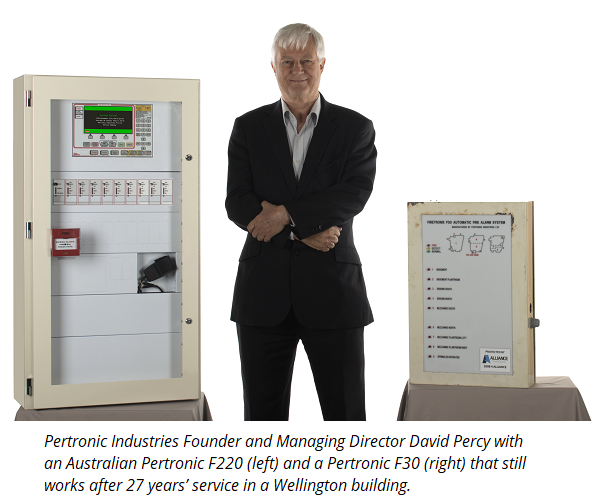- Home
-
Products
- Panels, Networking & Utilities Software
- Detectors, MCPs & Modules
- Alarm (Alerting) Devices
- Power Supplies
- Waterflow Devices
- Spare Parts
- Historic Products
- News
- Downloads
- Tools
- Projects
- About
- Support
- Sitemap
- BPIR
- Contact
News
From F30 to F220: The Evolution of a Masterpiece

Pertronic Industries introduced its first fire panel in 1986. Designed by company founder David Percy, the very successful Pertronic F30 used conventional detection technology and was available in two variants. The standard F30 was able to monitor up to 30 detection zones, while the mini version could monitor up to ten detection zones.
In 1991 we launched our first micro-processor controlled panel, the F40. This had an LCD display, keyboard, mappable relays, mappable LEDs, and a history log. The F40 could monitor up to 255 responder modules, which were mounted remote from the panel. Conventional responders had multiple detection zones. Later, an addressable responder allowed analogue addressable detectors to be used in Pertronic fire systems.
During the mid to late 1990s we introduced the microprocessor-controlled Pertronic F1, F4, and F16 conventional panels. These had universal detection zones: Each zone could have a mix of smoke and heat detectors and manual call points.
The F40 was replaced in the late 1990s by the F100A and F120A analogue addressable panels. With built-in analogue addressable loop drivers, these panels significantly reduced cabling requirements. Their LCD displays clearly identify the source of any alarm. The F100A and F120A can be configured to control a wide range of building services via analogue addressable modules.
Cause and effect logic capabilities in the F120A allow the programming of project-specific functionality.
Following the introduction of the F100A and F120A, we progressively expanded our product range to include networking, remote monitoring and diagnostics, and the FireMap PC graphic system.
In August 1999 we introduced Firebits, to provide regular updates for Pertronic customers.
The Pertronic F220
Our latest fire panel brings new capabilities to the fire panel market. Designed around powerful ARM processors, the F220 does far more than simply collect and respond to data. The F220 can analyse information about hundreds of thousands of events and present the results in practical, user-friendly formats. We wanted the new panel to save time and money for installation contractors and facility managers. We hoped it would help fire-fighters save lives.
The F30 was very simple. But it was versatile and expandable. Those themes of simplicity, versatility and expandability ultimately led to the Pertronic F220. In Australia the F220 has proven ideal across a wide spectrum of projects, from small systems with one or two loops, to eighty-story skyscrapers and motorway tunnels with more than a hundred networked panels. We are proud to release the New Zealand variant of the F220.
Posted in General; Tagged F220, Analogue Addressable, Conventional Detection, Fire Alarm Control Panels;
Tags
- Alerting Devices
- Amplifiers
- Analogue Addressable
- Audio Distribution Modules
- Cabling
- Conventional Beam Detectors
- Conventional Detection
- Covid_19
- Deluge System
- Detectors
- Drip Loop
- Early Warning Fire Detection
- Equipment Cabinets
- Events
- F100A
- F16e
- F220
- F4
- FAAST
- Fire Alarm Control Panels
- Fire Alarm Mini Panel
- Fire Alarm Panel Keyswitch
- Fire Door Holders
- Fire Graphic System
- Fire Show
- Fire System Management Application
- FireMap
- FireUtils
- Hazardous Area Detection
- Honeywell
- Interfaces and Repeaters
- interns
- IYM
- LED Mimic
- Linear Heat Detection
- Lockdown
- Manual Call Points
- manufacturing
- Net2 Network Systems
- Operations
- OSID - Open Area Smoke Imaging Detection
- Pertronic Offices
- Pertronic Production
- Pertronic SOS
- Product Support
- R&D
- recycling
- Remote Display
- research
- Residential Panel
- Seismic-tested Fire Alarm Panel
- smoke sensor
- Speakers
- Sprinkler FBA
- STEMM
- Strobes
- Suppression
- Takina
- Thermistor Heat Detectors
- Tools
- training
- Unwanted Alarm
- Waterflow Devices
- Weatherproof
- Weatherproof Detectors
- Wiring

